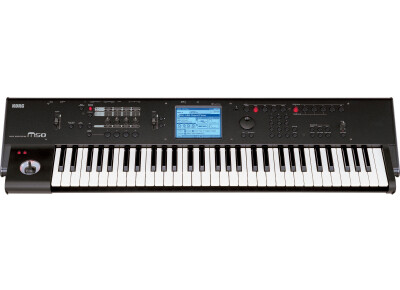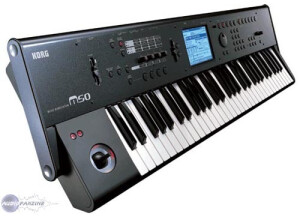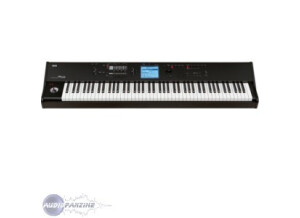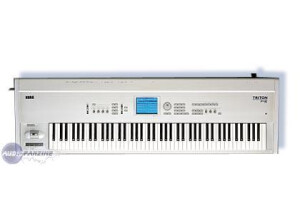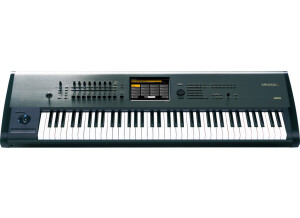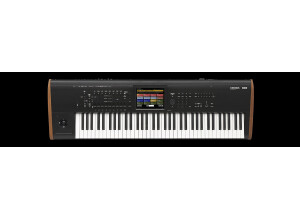Tech. sheet
- Manufacturer: Korg
- Model: M50 61
- Series: M50
- Category: Workstations
- Other names:m50 61
We have no technical specifications for this product
but your help will be much welcomed
»
News
Videos
User reviews
4.0/5(12 reviews)
5
50 %
4
25 %
3
2
8 %
1
8 %
Solid Workstation
Published on 08/11/11 at 06:37This is another one of those boards that comes industry ready right out of the box. It’s extremely easy to get it set up and ready to start making great music. The editing abilities on this board are easy to do and the workstation is easy to navigate. I love the pitch and modulation on this board, works great and is very smooth.
UTILIZATION
The manual is very easy to understand and is concise and in depth. But unfortunately the manual doesn’t come in a printed version. Some of use love to have hard copies of a manual and don’t want to have to pop in a cd just for a reference on something we might need to check or to do. Even with the ease of computers, I still prefer a hard copy of a...…
UTILIZATION
The manual is very easy to understand and is concise and in depth. But unfortunately the manual doesn’t come in a printed version. Some of use love to have hard copies of a manual and don’t want to have to pop in a cd just for a reference on something we might need to check or to do. Even with the ease of computers, I still prefer a hard copy of a...…
Read more
This is another one of those boards that comes industry ready right out of the box. It’s extremely easy to get it set up and ready to start making great music. The editing abilities on this board are easy to do and the workstation is easy to navigate. I love the pitch and modulation on this board, works great and is very smooth.
UTILIZATION
The manual is very easy to understand and is concise and in depth. But unfortunately the manual doesn’t come in a printed version. Some of use love to have hard copies of a manual and don’t want to have to pop in a cd just for a reference on something we might need to check or to do. Even with the ease of computers, I still prefer a hard copy of a manual so I can just index what I’m looking for and find it and understand what I need. I don’t like having to find the cd and put it in just for a quick reference.
SOUNDS
This board comes stock with a lot of sounds that sound great and are very warm and clean. The brass sounds are really realistic in my opinion. I was very surprise with the quality of the brass sounds and presets.
The Piano sounds didn’t impress me and weren’t as good as they are on the other boards that are out in the music world today. The just didn’t seem as realistic and warm as I am use to with the Fantom and Motif. Choir and Organ patches are good and unique sounding patches, but nothing that blows other boards out of the water, just very basic sounding patches.
OVERALL OPINION
Overall this is a very good keyboard, the synths on this board have the weird feel to them, great board for techno or club music. This board is pretty expensive but not as bad as a lot of other professional boards on the market.
UTILIZATION
The manual is very easy to understand and is concise and in depth. But unfortunately the manual doesn’t come in a printed version. Some of use love to have hard copies of a manual and don’t want to have to pop in a cd just for a reference on something we might need to check or to do. Even with the ease of computers, I still prefer a hard copy of a manual so I can just index what I’m looking for and find it and understand what I need. I don’t like having to find the cd and put it in just for a quick reference.
SOUNDS
This board comes stock with a lot of sounds that sound great and are very warm and clean. The brass sounds are really realistic in my opinion. I was very surprise with the quality of the brass sounds and presets.
The Piano sounds didn’t impress me and weren’t as good as they are on the other boards that are out in the music world today. The just didn’t seem as realistic and warm as I am use to with the Fantom and Motif. Choir and Organ patches are good and unique sounding patches, but nothing that blows other boards out of the water, just very basic sounding patches.
OVERALL OPINION
Overall this is a very good keyboard, the synths on this board have the weird feel to them, great board for techno or club music. This board is pretty expensive but not as bad as a lot of other professional boards on the market.
See less
00
»
Published on 03/15/09 at 15:29
(Originally written by G. Hagen/translated from Audiofanzine FR)
I bought this Korg MS50-61 two months ago. It's a modern workstation (in September 2008):
_ Five octaves, 80-voice polyphony
_ 1077 samples in 608 fully editable programs
_ 32 user programs
_ One GM2 compatibe sound bank
_ 48 drum kits
_ 384 combinations (expandable up to 896)
_ Four assignable controls (volume, effects, filters, envelopes, etc.)
_ One classic pitch (but no ribbon controller)
_ Two assignable switches
_ Four pads assignable to chords
_ One drum track allowing the use of 600 pre-recorded patterns
_ arpeggiator
_ 16 track sequencer
_ 170 effects usable with five effect inserts, two...…
I bought this Korg MS50-61 two months ago. It's a modern workstation (in September 2008):
_ Five octaves, 80-voice polyphony
_ 1077 samples in 608 fully editable programs
_ 32 user programs
_ One GM2 compatibe sound bank
_ 48 drum kits
_ 384 combinations (expandable up to 896)
_ Four assignable controls (volume, effects, filters, envelopes, etc.)
_ One classic pitch (but no ribbon controller)
_ Two assignable switches
_ Four pads assignable to chords
_ One drum track allowing the use of 600 pre-recorded patterns
_ arpeggiator
_ 16 track sequencer
_ 170 effects usable with five effect inserts, two...…
Read more
(Originally written by G. Hagen/translated from Audiofanzine FR)
I bought this Korg MS50-61 two months ago. It's a modern workstation (in September 2008):
_ Five octaves, 80-voice polyphony
_ 1077 samples in 608 fully editable programs
_ 32 user programs
_ One GM2 compatibe sound bank
_ 48 drum kits
_ 384 combinations (expandable up to 896)
_ Four assignable controls (volume, effects, filters, envelopes, etc.)
_ One classic pitch (but no ribbon controller)
_ Two assignable switches
_ Four pads assignable to chords
_ One drum track allowing the use of 600 pre-recorded patterns
_ arpeggiator
_ 16 track sequencer
_ 170 effects usable with five effect inserts, two master effects and one global effect
_ Two Midi connectors, two audio outputs, phones output, two foot controller connectors, damper connector for sustain pedal, 2GB card reader, USB port
_ Touch screen for more intuitiveness.
UTILIZATION
Easy configuration if you're used to Korg devices. It works like a computer: each screen displays one page with several tabs. I can still remember the time when we only had LCD displays, but modern touch screens make everything much easier.
Sound and effect editing is easy but the possibilities are so many that you can get lost pretty quickly. For example, after two months I stilt can't use master and global effects. But I can easily chain five insert effects to get a rotary speaker for an organ, an exciter for the drums (they need it), a distortion for a lead guitar and a chorus for a rhythm guitar, plus a reverb for the whole of it. That would be impossible with a T1!
I have a complaint regarding the user's manual: The printed manual isn't comprehensive enough. Why is the 400-page parameter guide only provided on CD?!
SOUNDS
I first worked with the Yamaha PSR 410 then with the Korg T3. I wanted to change to a Yamaha S 700. But I finally chose the M50, which confirms that Korg is better than Yamaha regarding sound. Of course, it's all a matter of taste. I like orchestral music, rock, jazz, pop and techno. And for these music styles, the M50 seems to be more comprehensive and it has a very authentic sound.
_ It provides endless strings that complement each other. The A007 patch (Intimate Strings) sounds warm and lyrical. Tremolo strings are frightening. At least two string quartets give me a thrill due to the authenticity of their vibrato.
_ Brass patches are also surprising and convincing. It's true that vibrato is sometimes too present. But once again, you get very comprehensive sound possibilities: solo trumpet, trumpet duo or section, muted, with or without vibrato. Same thing for the trombone, French horn and tuba. Lots of different brass sections ranging from very synthetic to authentic jazz section.
_ Piano patches. Acoustic pianos have been greatly improved: just compare them with the M50 (A000) and the M1 (A049). The unit also provides many different electric piano patches (almost too many).
_ Plenty good-sounding choir patches. The classical chorus sounds amazing.The Mountain Voices patch sounds great: you can hear farmers taking their herds to high mountain pastures.
_ Liturgical organs: at last a synth that provides different and authentic sounding patches! It doesn't sound like a pathetic boosted accordion!
_ Electric organs: you'll surely find the right sound among the several patches. The rotary speaker effect doesn't sound that authentic because it's still too fast. But you can edit all effect parameters. From Hammond to DGWS organs, everything is possible.
_ Drums: 48 drum kits ought to be enough, from jazz, to rap, hip-pop and house kits. The keyboard layout of the main kit components (bass drum, snare, toms, crash, cymbals, triangle, etc.) is the same for all kits, following Yamaha's standard layout, which is very convenient. You also get ethnic kits (Brazilian for example) and orchestral kits. The Chinese gong is impressive...
_ Bass guitar patches: Huge number of patches, I haven't tried them all out. They subharmonics allow you to imitate Björk's style without sounding ridiculous. On the jazz double bass, you can actually hear the fingers moving over the strings!
_ Acoustic guitars: their attack sounds too massive. In spite of that the nylon guitar (A004) sounds wonderful. On the other hand, all 12-string guitars sound like a supermarket harpsichord. It's surprising because guitar patches were the highlight of the Korg T1. Luckily, electro-acoustic guitars sound better.
_ Lead guitars sound very good. The variety of patches is much better than on of my T3. You can mimic every noise a guitarist can generate with his instrument.
_ Synth patches are sorted in fast, slow and motions. I haven't tested all of them yet.
_ SFX patches: Great if you like to add weird sounds to your songs. Dogs, horses, car, door, storm, rain, lightning, train, scream, laugh, jungle, birds... Almost anything you can imagine. The T1 could even burp! The M50 is more polite... but it has no sampler anymore (it's big brother, the M3 does have a sampler but it's also much more expensive!). It's a pity...
_ Wood instruments: Flute patches sound warm (but the vibrato is too present) and clarinet patches sound beautiful. The M50 really makes a difference in respect to the T3 when it comes to oboe, horn and bassoon patches. Most saxophone patches sound good. They have a great groove when you play with the pitch parameter! On one patch you can even hear the breath of the saxophonist! But the sound is not authentic anymore when you play high notes. The synth provides different soprano, alto, tenor (wonderful) and baritone saxophones. The difference between each of them is clearly audible. And you also have saxophone section patches.
_ Melodic percussions: countless bells, xylophone, steel drums, vibraphone, kalimba, marimba, celesta, etc.
As a summary, I like the playing feel and the sound.
OVERALL OPINION
After two months of use, I'm still in love with it because the M50 keeps on surprising me. It's light (15 lb.), it looks good (but the bottom side is fragile because it's made out of plastic) and it's convenient. What do I like the most? The powerful sound engine even if it doesn't provide expansion possibilities (via PCM card for example) unlike the M3. I didn't choose this product for the Drum track or arpeggiator but these functions are powerful and might inspire me in the future.
I planned to buy a Yamaha S 700 to replace my T3. I also thought about the Korg PA500 (but it's an arranger keyboard not a workstation). And I discovered the M3... Beautiful, professional... and very expensive! Then came the M50. The first time I played it I knew it would be MY instrument. I don't regret having bought it.
Unbeatable value for money: you get the sound engine of the M3 without a sampler or the Karma and Radias systems, but it's still expensive.
I hope I can use it to create my songs the next 15 years!
I bought this Korg MS50-61 two months ago. It's a modern workstation (in September 2008):
_ Five octaves, 80-voice polyphony
_ 1077 samples in 608 fully editable programs
_ 32 user programs
_ One GM2 compatibe sound bank
_ 48 drum kits
_ 384 combinations (expandable up to 896)
_ Four assignable controls (volume, effects, filters, envelopes, etc.)
_ One classic pitch (but no ribbon controller)
_ Two assignable switches
_ Four pads assignable to chords
_ One drum track allowing the use of 600 pre-recorded patterns
_ arpeggiator
_ 16 track sequencer
_ 170 effects usable with five effect inserts, two master effects and one global effect
_ Two Midi connectors, two audio outputs, phones output, two foot controller connectors, damper connector for sustain pedal, 2GB card reader, USB port
_ Touch screen for more intuitiveness.
UTILIZATION
Easy configuration if you're used to Korg devices. It works like a computer: each screen displays one page with several tabs. I can still remember the time when we only had LCD displays, but modern touch screens make everything much easier.
Sound and effect editing is easy but the possibilities are so many that you can get lost pretty quickly. For example, after two months I stilt can't use master and global effects. But I can easily chain five insert effects to get a rotary speaker for an organ, an exciter for the drums (they need it), a distortion for a lead guitar and a chorus for a rhythm guitar, plus a reverb for the whole of it. That would be impossible with a T1!
I have a complaint regarding the user's manual: The printed manual isn't comprehensive enough. Why is the 400-page parameter guide only provided on CD?!
SOUNDS
I first worked with the Yamaha PSR 410 then with the Korg T3. I wanted to change to a Yamaha S 700. But I finally chose the M50, which confirms that Korg is better than Yamaha regarding sound. Of course, it's all a matter of taste. I like orchestral music, rock, jazz, pop and techno. And for these music styles, the M50 seems to be more comprehensive and it has a very authentic sound.
_ It provides endless strings that complement each other. The A007 patch (Intimate Strings) sounds warm and lyrical. Tremolo strings are frightening. At least two string quartets give me a thrill due to the authenticity of their vibrato.
_ Brass patches are also surprising and convincing. It's true that vibrato is sometimes too present. But once again, you get very comprehensive sound possibilities: solo trumpet, trumpet duo or section, muted, with or without vibrato. Same thing for the trombone, French horn and tuba. Lots of different brass sections ranging from very synthetic to authentic jazz section.
_ Piano patches. Acoustic pianos have been greatly improved: just compare them with the M50 (A000) and the M1 (A049). The unit also provides many different electric piano patches (almost too many).
_ Plenty good-sounding choir patches. The classical chorus sounds amazing.The Mountain Voices patch sounds great: you can hear farmers taking their herds to high mountain pastures.
_ Liturgical organs: at last a synth that provides different and authentic sounding patches! It doesn't sound like a pathetic boosted accordion!
_ Electric organs: you'll surely find the right sound among the several patches. The rotary speaker effect doesn't sound that authentic because it's still too fast. But you can edit all effect parameters. From Hammond to DGWS organs, everything is possible.
_ Drums: 48 drum kits ought to be enough, from jazz, to rap, hip-pop and house kits. The keyboard layout of the main kit components (bass drum, snare, toms, crash, cymbals, triangle, etc.) is the same for all kits, following Yamaha's standard layout, which is very convenient. You also get ethnic kits (Brazilian for example) and orchestral kits. The Chinese gong is impressive...
_ Bass guitar patches: Huge number of patches, I haven't tried them all out. They subharmonics allow you to imitate Björk's style without sounding ridiculous. On the jazz double bass, you can actually hear the fingers moving over the strings!
_ Acoustic guitars: their attack sounds too massive. In spite of that the nylon guitar (A004) sounds wonderful. On the other hand, all 12-string guitars sound like a supermarket harpsichord. It's surprising because guitar patches were the highlight of the Korg T1. Luckily, electro-acoustic guitars sound better.
_ Lead guitars sound very good. The variety of patches is much better than on of my T3. You can mimic every noise a guitarist can generate with his instrument.
_ Synth patches are sorted in fast, slow and motions. I haven't tested all of them yet.
_ SFX patches: Great if you like to add weird sounds to your songs. Dogs, horses, car, door, storm, rain, lightning, train, scream, laugh, jungle, birds... Almost anything you can imagine. The T1 could even burp! The M50 is more polite... but it has no sampler anymore (it's big brother, the M3 does have a sampler but it's also much more expensive!). It's a pity...
_ Wood instruments: Flute patches sound warm (but the vibrato is too present) and clarinet patches sound beautiful. The M50 really makes a difference in respect to the T3 when it comes to oboe, horn and bassoon patches. Most saxophone patches sound good. They have a great groove when you play with the pitch parameter! On one patch you can even hear the breath of the saxophonist! But the sound is not authentic anymore when you play high notes. The synth provides different soprano, alto, tenor (wonderful) and baritone saxophones. The difference between each of them is clearly audible. And you also have saxophone section patches.
_ Melodic percussions: countless bells, xylophone, steel drums, vibraphone, kalimba, marimba, celesta, etc.
As a summary, I like the playing feel and the sound.
OVERALL OPINION
After two months of use, I'm still in love with it because the M50 keeps on surprising me. It's light (15 lb.), it looks good (but the bottom side is fragile because it's made out of plastic) and it's convenient. What do I like the most? The powerful sound engine even if it doesn't provide expansion possibilities (via PCM card for example) unlike the M3. I didn't choose this product for the Drum track or arpeggiator but these functions are powerful and might inspire me in the future.
I planned to buy a Yamaha S 700 to replace my T3. I also thought about the Korg PA500 (but it's an arranger keyboard not a workstation). And I discovered the M3... Beautiful, professional... and very expensive! Then came the M50. The first time I played it I knew it would be MY instrument. I don't regret having bought it.
Unbeatable value for money: you get the sound engine of the M3 without a sampler or the Karma and Radias systems, but it's still expensive.
I hope I can use it to create my songs the next 15 years!
See less
00
»
Published on 02/05/09 at 11:19 (This content has been automatically translated from French)
A bomb !!!!!!!!!!!!!!!!!!!!!!!!!!!!
USE
Very simple
SOUNDS
Varied
NOTICE GLOBAL
Buy !!
USE
Very simple
SOUNDS
Varied
NOTICE GLOBAL
Buy !!
00
»
A BIG DISAPPOINTMENT
Published on 10/28/13 at 20:17 (This content has been automatically translated from French)The Korg M50 Workstation is released in 2008, making many think M1 and who gets the synthesis engine of the M3 without KARMA. At first impressions, it is quite nice especially in black with slightly sloping façade which makes reading the screen and is lightweight 6-7kg ... it changes your life especially when you still had Motif or Triton 17kg.
- 61 semi-weighted keys, hit a pretty average compared to the old worksation, but today it is the 1000th completed aftertouch.
- Output XLR Mono / stereo headphone jack, SD card slot, USB connectors, jacks for pedals ... well the bare minimum.
- 256 MB of memory waveforms (1,077 multisamples and 1,609 drum samples) .. short there is plenty...…
- 61 semi-weighted keys, hit a pretty average compared to the old worksation, but today it is the 1000th completed aftertouch.
- Output XLR Mono / stereo headphone jack, SD card slot, USB connectors, jacks for pedals ... well the bare minimum.
- 256 MB of memory waveforms (1,077 multisamples and 1,609 drum samples) .. short there is plenty...…
Read more
The Korg M50 Workstation is released in 2008, making many think M1 and who gets the synthesis engine of the M3 without KARMA. At first impressions, it is quite nice especially in black with slightly sloping façade which makes reading the screen and is lightweight 6-7kg ... it changes your life especially when you still had Motif or Triton 17kg.
- 61 semi-weighted keys, hit a pretty average compared to the old worksation, but today it is the 1000th completed aftertouch.
- Output XLR Mono / stereo headphone jack, SD card slot, USB connectors, jacks for pedals ... well the bare minimum.
- 256 MB of memory waveforms (1,077 multisamples and 1,609 drum samples) .. short there is plenty to do.
- There are also four small pads to record four agreements and play with ... it is a little gadget.
For the rest I invite you to look at the data sheet
UTILIZATION
Navigation is made easy thanks to the touch screen quality. It is very simple to find what you are looking for in the different categories of sounds. There are several COMBI mode, PROG, SEQ ... etc. also have their assigned command impossible to get lost on this side ... Korg has always been rather readable at its interfaces even if for having a Korg Trinity Tritons and testing I have to say that the OS did not change much since then and if you have ever had Korgs you will not be out of place.
The manual is in French but a little light especially for the use of sequencer and editions and sounds and effects. A more comprehensive manual is available on the net but only in English. That said editing software is included with the M5O and make you the easiest and most accurate things like most modern synth. After this is not very complicated but not for those starting force yourself to study a little manual ... touch screen tends to make you fall in ease and then we easily magnifier important settings.
Consider having a SD card for backup and 2GB max to save all (Dial, editions, SETTINGS ...) because the M50 does not keep anything in memory.
Last remark it happens that sometimes the keyboard alone blocks which can be very annoying for those who do live ... In fact it is just necessary to update the OS
SOUNDS
In terms of sound, it's pretty good, but there is a lot to say it anyway:
- For piano, Korg put the package ... there's really a lot of choice between pretty good acoustic pianos, organs, electric pianos some rhodes etc ... it is rather a strong point on the keyboard.
- Violins are also quite varied and
- The guitars I do not necessarily find thunderous but hey it is my personal opinion
- The electro sounds like the lead, motion ... are really prehistoric and must all re-edit from the outset whether or arpeggios sounds themselves ... I hallucinated because the keyboard is very electro and typed in this field is its weak point. I had a pattern with less than a one is light years.
- The rest is just the same leaning a bit overwhelmed especially if you are of modern music, anyway keyboard does not sound vintage so this is more for those who make electronic music (hous etechno, dub step , modern hip hop to electro sauce)
- I'd end up a good note so as not to discourage you, drum kits are very good and many modern, which allows for a bit of terrain.
You each class of sounds free beaches to multiply editions sound and increase your database. But hey when you know there are already a lot of work to do with those already available ... it's frustrating final
Combi mode is pretty nice, there a lot of pre-recorded patterns and you can choose the desired pattern on each program to play a rhythm. It is possible to edit its patterns.
Finally for the KORG sequencer is, I do not like too much logic and I use my Mac and software sequencing therefore share tell you that it is to record what goes through your head forget it .. it stops there. In addition, the sound loses a little in intensity and impact in the recording mode.
The arpeggiator is correct for the machine price ... or ... or fabulous top.
OVERALL OPINION
I got a little immortalized on the sounds but it is above all the plays on the M50.
I thought by buying like why not acquire a more modern worstation and indeed I am happy to have been for nothing because in the end I sold it quickly before it becomes a burden. In fact, it has everything, retro design, ease of utlitisation, Workstation réçente therefore in principle for the times ... But apart from the piano I am appalled to see that Korg did not give us a pannel Electro (Lead, Motion) ... more on page ... you have to rework all the source and ç'est still mad at that price it does not have the bare minimum ... especially for a well-typed electronic keyboard at the base as M50 ... it is the height anyway ... Basically you buy this kind of machine to the modern sound and save time ... where c ' Quite the opposite ... I feel that it is designed as a digital piano, but not as a true workstation. I assigned a 4/10 that is insufficient for a 61 or 73-key Workstation 2008. For M5O 88 it can be a very good digital piano ...
For those looking to make his drop ... it's a real waste of time and really poor side of Electro ... I also not understand the test audiofanzine unless c is me that is no, I would not call the M50 as a small but as a gifted handicapped by its glaring shortcomings. it reminds me of a beautiful 205 GTI Tuning that a diesel engine ... it looks like a racing machine but in fact it just needs work ...
I know this is a good entry level but there is a minimum ... Anyway A big disappointment.
- 61 semi-weighted keys, hit a pretty average compared to the old worksation, but today it is the 1000th completed aftertouch.
- Output XLR Mono / stereo headphone jack, SD card slot, USB connectors, jacks for pedals ... well the bare minimum.
- 256 MB of memory waveforms (1,077 multisamples and 1,609 drum samples) .. short there is plenty to do.
- There are also four small pads to record four agreements and play with ... it is a little gadget.
For the rest I invite you to look at the data sheet
UTILIZATION
Navigation is made easy thanks to the touch screen quality. It is very simple to find what you are looking for in the different categories of sounds. There are several COMBI mode, PROG, SEQ ... etc. also have their assigned command impossible to get lost on this side ... Korg has always been rather readable at its interfaces even if for having a Korg Trinity Tritons and testing I have to say that the OS did not change much since then and if you have ever had Korgs you will not be out of place.
The manual is in French but a little light especially for the use of sequencer and editions and sounds and effects. A more comprehensive manual is available on the net but only in English. That said editing software is included with the M5O and make you the easiest and most accurate things like most modern synth. After this is not very complicated but not for those starting force yourself to study a little manual ... touch screen tends to make you fall in ease and then we easily magnifier important settings.
Consider having a SD card for backup and 2GB max to save all (Dial, editions, SETTINGS ...) because the M50 does not keep anything in memory.
Last remark it happens that sometimes the keyboard alone blocks which can be very annoying for those who do live ... In fact it is just necessary to update the OS
SOUNDS
In terms of sound, it's pretty good, but there is a lot to say it anyway:
- For piano, Korg put the package ... there's really a lot of choice between pretty good acoustic pianos, organs, electric pianos some rhodes etc ... it is rather a strong point on the keyboard.
- Violins are also quite varied and
- The guitars I do not necessarily find thunderous but hey it is my personal opinion
- The electro sounds like the lead, motion ... are really prehistoric and must all re-edit from the outset whether or arpeggios sounds themselves ... I hallucinated because the keyboard is very electro and typed in this field is its weak point. I had a pattern with less than a one is light years.
- The rest is just the same leaning a bit overwhelmed especially if you are of modern music, anyway keyboard does not sound vintage so this is more for those who make electronic music (hous etechno, dub step , modern hip hop to electro sauce)
- I'd end up a good note so as not to discourage you, drum kits are very good and many modern, which allows for a bit of terrain.
You each class of sounds free beaches to multiply editions sound and increase your database. But hey when you know there are already a lot of work to do with those already available ... it's frustrating final
Combi mode is pretty nice, there a lot of pre-recorded patterns and you can choose the desired pattern on each program to play a rhythm. It is possible to edit its patterns.
Finally for the KORG sequencer is, I do not like too much logic and I use my Mac and software sequencing therefore share tell you that it is to record what goes through your head forget it .. it stops there. In addition, the sound loses a little in intensity and impact in the recording mode.
The arpeggiator is correct for the machine price ... or ... or fabulous top.
OVERALL OPINION
I got a little immortalized on the sounds but it is above all the plays on the M50.
I thought by buying like why not acquire a more modern worstation and indeed I am happy to have been for nothing because in the end I sold it quickly before it becomes a burden. In fact, it has everything, retro design, ease of utlitisation, Workstation réçente therefore in principle for the times ... But apart from the piano I am appalled to see that Korg did not give us a pannel Electro (Lead, Motion) ... more on page ... you have to rework all the source and ç'est still mad at that price it does not have the bare minimum ... especially for a well-typed electronic keyboard at the base as M50 ... it is the height anyway ... Basically you buy this kind of machine to the modern sound and save time ... where c ' Quite the opposite ... I feel that it is designed as a digital piano, but not as a true workstation. I assigned a 4/10 that is insufficient for a 61 or 73-key Workstation 2008. For M5O 88 it can be a very good digital piano ...
For those looking to make his drop ... it's a real waste of time and really poor side of Electro ... I also not understand the test audiofanzine unless c is me that is no, I would not call the M50 as a small but as a gifted handicapped by its glaring shortcomings. it reminds me of a beautiful 205 GTI Tuning that a diesel engine ... it looks like a racing machine but in fact it just needs work ...
I know this is a good entry level but there is a minimum ... Anyway A big disappointment.
See less
1110
»

